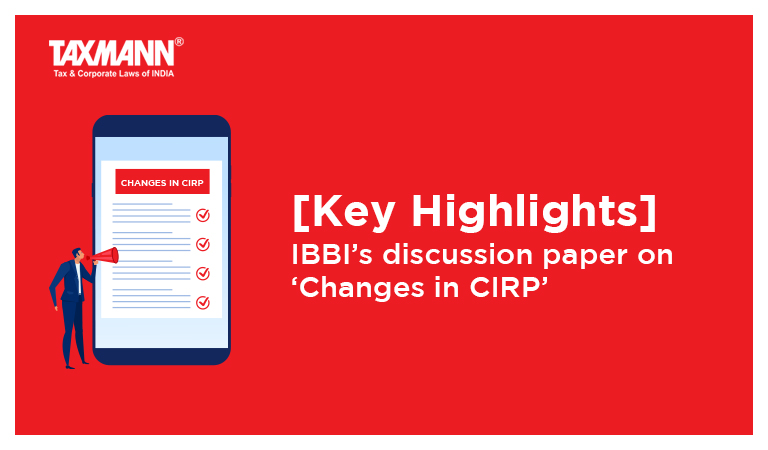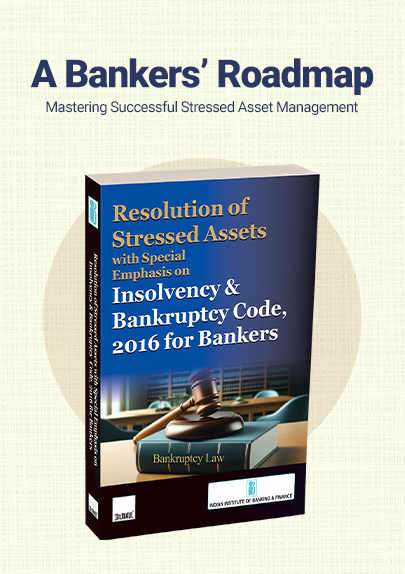[Key Highlights] IBBI’s discussion paper on ‘Changes in CIRP’
- Blog|News|Insolvency and Bankruptcy Code|
- 4 Min Read
- By Taxmann
- |
- Last Updated on 29 June, 2022
IBBI News dated 27.06.2022
The IBBI has floated a discussion paper on June 27, 2022 whereby it has proposed various changes in the corporate insolvency resolution process thereby aimed at reducing delays and improving the resolution value.
The key proposals include
(i) reduction of timelines for inviting Expression of Interest (EoI)
(ii) Increase in the timelines for preparation of Information Memorandum (IM)
(iii) Reduction of timelines for ‘Avoidance-Transaction’ related matters
(iv) Casting duty on the RP to make a strategy for the marketing of assets of corporate debtor
(v) mandatorily geo-tagging of immovable assets of corporate debtor by IP
(vi) Providing an opportunity to CoC to interact with valuers
(vii) Linking of the payment made to dissenting financial creditor to the realizable amount at the time of liquidation
(viii) Providing timely information to creditors w.r.t initiation of CIRP & last date for filing claims
The proposals made by the Insolvency & Bankruptcy Board of India (IBBI) are discussed hereunder in detail:
1. Reduction of time-line for inviting Expression of Interest (EOI)
As per regulation 36A of the IBBI (Insolvency Resolution Process for Corporate Persons) Regulations, 2016. The Expression of Interest (EoI) shall be invited within 75 days of the commencement of the CIPR proceedings.
The IBBI observed that on basis of finer analysis, it became apparent that for inviting expression of Interest from the prospective resolution applicants, an information memorandum per se is not required as at this stage only basic information of the corporate debtor is required to be given while inviting EOI etc. An Information Memorandum is required at the time of issue of request for a resolution plan. So, the activity of invitation of EOI can be started much earlier. The proposal is made that the EoI shall be invited within 60 days of the commencement of the CIPR proceedings.
2. Increase in the timeline for preparation of Information Memorandum (IM)
As per regulation 36 (1) of the IBBI (Insolvency Resolution Process for Corporate Persons) Regulations, 2016 the Resolution Professional (RP) shall submit the Information Memorandum (IM) to the Committee of Creditors (CoC) within 2 weeks of his appointment, but not later than 54th day of commencement.
The IBBI observed that RPs are not able to prepare and submit the IM to the CoC members within the currently prescribed timeliness due to the lack of information, incomplete books of accounts, and non-cooperation from promoters. The IM is a critical document that is the basis on which resolution applicants propose resolution plans. Therefore, it is proposed to increase the timeline for the preparation of IM to 95 days from the date of commencement so that sufficient time is available to the RP within the overall timeline.
3. Reduction in the timeline for ‘avoidance transaction’ related matters
As per regulation 35A of the IBBI (Insolvency Resolution Process for Corporate Persons) Regulations, 2016 the present timeline of filing avoidance application is 135 days from the date of commencement which coincides the timeline for submission of resolution plan.
Therefore, it is proposed, proposed to decrease the time for filing of avoidance application to 130 days.
4. Casting the duty on the Resolution Professional (RP) to make Strategy for marketing of assets of the corporate debtor
The IBBI felt that maximising the value of Corporate Debtor under CIRP can happen only when there are multiple competing resolution plans and a price discovery takes place through competitive bidding among prospective resolution applicants. The information of the asset being available in the market needs to be disseminated to a wider audience and targeted outreach to potential resolution applicants, in order to improve interest and encourage participation.
Therefore, a new regulation 36C is proposed to be inserted which mandates that the resolution professional shall prepare a strategy for marketing of the assets of the corporate debtor, where the total claims exceed Rs.100 crore. Such strategy shall consist the measures that would be taken and the cost involved in the implementation and shall be prepared in consultation with the committee. The creditors can also propose and include measures that they would take in the marketing of assets of the corporate debtor as part of the strategy.
5. Insertion of regulation 37A; allowing submission of different resolution plans for these part assets/ businesses
IBBI has proposed to insert a new regulation 37A which would allow the RP and CoC would to explore resolutions of part assets/ businesses by allowing submission of different resolution plans for these part assets/ businesses, while a revised RFRP is issued.
This can be done where there were prospective resolution applicants expressing interest in the corporate debtor but no resolution plan was received after the time for submission of resolution plan has lapsed explore to resolve part of the assets of the corporate debtor.
6. Early liquidation of the corporate debtor on the basis of certain guiding factors
There are several CIRPs in which the CD is defunct and has no assets or insignificant assets, in the extreme cases the CD exists only on paper. In such cases the RP and the creditors have no option but to liquidate the CD.
The conduct of the CIRP where the chances of resolution do not exist imposes a cost on the creditors in paying to the RP and other process costs. It also delays the liquidation process.
In order to avoid such situations and to enable the CoC to arrive at an early decision a new regulation 40D is proposed to be inserted.
As per the proposed regulation while considering the liquidation of the CD, the CoC may consider factors such as non-operational status for the preceding 3 years, goods produced or services offered being obsolete, lack of intangible assets etc. that reflect the viability of the corporate debtor. These factors may be recorded and submitted in the application for liquidation order submitted by the resolution professional to the Adjudicating Authority.
Click Here To Read The Full Article
Disclaimer: The content/information published on the website is only for general information of the user and shall not be construed as legal advice. While the Taxmann has exercised reasonable efforts to ensure the veracity of information/content published, Taxmann shall be under no liability in any manner whatsoever for incorrect information, if any.

Taxmann Publications has a dedicated in-house Research & Editorial Team. This team consists of a team of Chartered Accountants, Company Secretaries, and Lawyers. This team works under the guidance and supervision of editor-in-chief Mr Rakesh Bhargava.
The Research and Editorial Team is responsible for developing reliable and accurate content for the readers. The team follows the six-sigma approach to achieve the benchmark of zero error in its publications and research platforms. The team ensures that the following publication guidelines are thoroughly followed while developing the content:
- The statutory material is obtained only from the authorized and reliable sources
- All the latest developments in the judicial and legislative fields are covered
- Prepare the analytical write-ups on current, controversial, and important issues to help the readers to understand the concept and its implications
- Every content published by Taxmann is complete, accurate and lucid
- All evidence-based statements are supported with proper reference to Section, Circular No., Notification No. or citations
- The golden rules of grammar, style and consistency are thoroughly followed
- Font and size that’s easy to read and remain consistent across all imprint and digital publications are applied






 CA | CS | CMA
CA | CS | CMA


